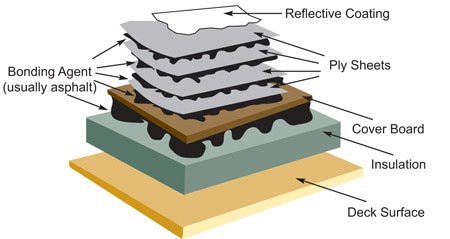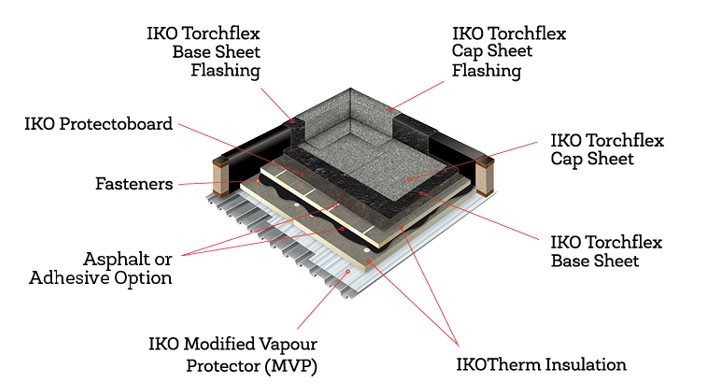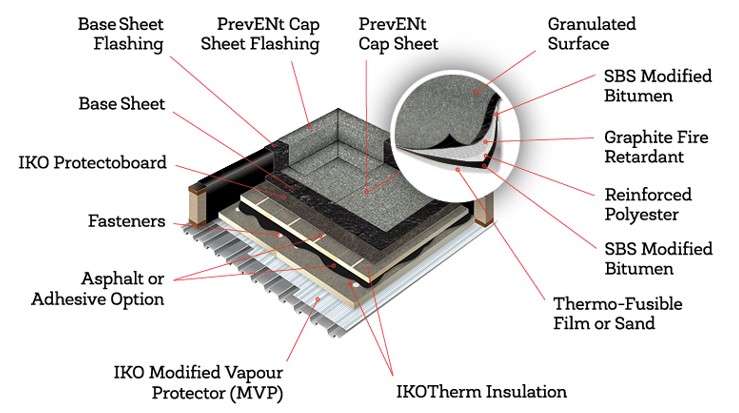You’re probably wondering how many layers a commercial roof has. Well, let’s shed some light on the topic. Commercial roofs, unlike residential roofs, are typically built with multiple layers for added durability and protection. These layers include insulation, a vapor barrier, a membrane, and a protective coating. Each layer serves a unique purpose in ensuring the longevity and functionality of the roof. So, let’s dig deeper into the fascinating world of commercial roofs and discover the intricacies of their layered construction.

Types of Commercial Roofs
Commercial roofs come in various types, each designed to meet specific needs and requirements. Understanding the different types can help you choose the right commercial roof for your building. Here are some common types of commercial roofs:
Built-up Roofing (BUR)
Built-up roofing, also known as BUR, is one of the most traditional types of commercial roofing systems. It consists of multiple layers of asphalt and felt that are built up to create a durable and weather-resistant roof. BUR roofs are known for their longevity and can withstand heavy foot traffic.
Single-Ply Membrane Roofing
Single-ply membrane roofing is a popular choice for commercial roofs due to its durability and cost-effectiveness. It is made of a single layer of synthetic material, such as PVC or EPDM, that is applied directly to the roof surface. These membranes are highly resistant to UV rays, chemicals, and punctures, making them a reliable choice for various commercial buildings.
Modified Bitumen
Modified bitumen roofing is a type of asphalt-based roofing that is reinforced with fiberglass or polyester. It is known for its strength and flexibility, allowing it to withstand extreme temperature changes and heavy foot traffic. Modified bitumen roofs can be installed with a torch or cold-applied adhesives, providing a seamless and watertight roofing system.
Metal Roofing
Metal roofing is a durable and long-lasting option for commercial roofs. It is available in various metal materials, such as aluminum, steel, and copper. Metal roofs are known for their strength, resistance to fire, and ability to shed snow and rain easily. They can be installed as panels or shingles, giving the building a modern and sleek look.
Thermoplastic Roofing
Thermoplastic roofing, also known as TPO roofing, is a popular choice for commercial buildings due to its energy efficiency and durability. TPO roofs are made of a single layer of thermoplastic material that is heat-welded together to form a seamless and watertight membrane. They are known for their resistance to UV rays, chemicals, and punctures.
Thermoset Roofing
Thermoset roofing, also known as EPDM roofing, is a synthetic rubber roofing material that is highly durable and long-lasting. EPDM roofs are resistant to UV rays, ozone, and chemicals, making them ideal for commercial buildings. They can be installed as large sheets or adhered to the roof surface.
Layers of a Built-up Roofing (BUR)
Built-up roofing, or BUR, consists of multiple layers that work together to create a strong and durable roof system. Understanding the layers of a BUR roof can help in its installation and maintenance. Here are the layers of a built-up roofing system:
Base Sheet
The base sheet is the first layer of a built-up roofing system. It is typically made of fiberglass or organic felt that is saturated with asphalt. The base sheet provides a solid foundation for the roof and helps to reinforce the overall structure.
Interply Sheets
Interply sheets are additional layers of felt that are installed between the base sheet and the cap sheet. These sheets are saturated with asphalt and are used to enhance the roof’s strength and durability.
Cap Sheet
The cap sheet is the topmost layer of a built-up roofing system. It is made of a combination of asphalt and aggregate materials, such as gravel or mineral granules. The cap sheet provides protection against weather elements and enhances the roof’s aesthetics.
Surfacing
Some built-up roofing systems include a surfacing layer, which is applied on top of the cap sheet. The surfacing can be a layer of gravel, mineral granules, or a reflective coating. The surfacing layer provides additional protection against UV rays and helps to prolong the life of the roof.
Layers of a Single-Ply Membrane Roofing
Single-ply membrane roofing systems consist of different layers that work together to create a durable and watertight roof. Understanding the layers of a single-ply membrane roofing system can help ensure its proper installation and maintenance. Here are the layers of a single-ply membrane roofing system:
Insulation Board
The insulation board is the first layer of a single-ply membrane roofing system. It provides thermal insulation and helps to improve the energy efficiency of the building. The insulation board can be made of materials such as polyisocyanurate (ISO), expanded polystyrene (EPS), or extruded polystyrene (XPS).
Single-Ply Membrane
The single-ply membrane is the core layer of the roofing system. It is typically made of synthetic materials, such as PVC or EPDM, that are known for their durability and resistance to UV rays, chemicals, and punctures. The single-ply membrane is installed in large sheets and is heat-welded or adhered to the roof surface.
Adhesive
The adhesive layer is used to bond the single-ply membrane to the insulation board or the roof deck. It ensures a strong and watertight seal between the layers of the roofing system. Different types of adhesives can be used, depending on the specific requirements and compatibility of the roofing materials.
Protective Layer
Some single-ply membrane roofing systems include a protective layer on top of the single-ply membrane. This layer can be a coating, such as acrylic or silicone, that provides additional protection against UV rays and weather elements. The protective layer also helps to prolong the life of the roof and enhance its aesthetics.
Layers of a Modified Bitumen Roofing
Modified bitumen roofing systems are known for their strength and durability. The layers of a modified bitumen roofing system work together to create a weather-resistant and long-lasting roof. Here are the layers of a modified bitumen roofing system:
Base Sheet
The base sheet is the first layer of a modified bitumen roofing system. It is typically made of fiberglass or polyester that is saturated with asphalt. The base sheet provides a solid foundation for the roofing system and helps to reinforce the overall structure.
Modified Bitumen Membrane
The modified bitumen membrane is the core layer of the roofing system. It is made of a blend of asphalt and synthetic materials, such as SBS (styrene butadiene styrene) or APP (atactic polypropylene). The modified bitumen membrane provides flexibility and durability, allowing it to withstand extreme temperature changes and heavy foot traffic.
Adhesive
The adhesive layer is used to bond the modified bitumen membrane to the base sheet or the roof deck. It ensures a strong and watertight seal between the layers of the roofing system. Different types of adhesives can be used, such as hot asphalt or cold-applied adhesives, depending on the specific requirements and compatibility of the roofing materials.

Layers of a Metal Roofing
Metal roofing is known for its durability, strength, and longevity. The layers of a metal roofing system work together to provide a weather-resistant and low-maintenance roof. Here are the layers of a metal roofing system:
Roof Deck
The roof deck is the first layer of a metal roofing system. It is the structural component of the roof that provides support and stability. The roof deck can be made of materials such as plywood or metal panels.
Insulation
The insulation layer is used to improve the energy efficiency of the building and provide thermal insulation. It helps to reduce heat transfer, keeping the interior of the building comfortable. The insulation layer can be made of materials such as fiberglass or rigid foam board.
Underlayment
The underlayment is a protective layer that is installed directly on top of the roof deck. It provides an additional barrier against water intrusion and helps to protect the roof from moisture damage. The underlayment can be made of materials such as asphalt-saturated felt or synthetic materials.
Metal Panels
The metal panels are the main component of a metal roofing system. They are usually made of materials such as aluminum, steel, or copper, which are known for their durability and resistance to fire, wind, and extreme weather conditions. Metal panels can be installed as standing seam panels, corrugated panels, or shingles, depending on the specific design and requirements of the building.
Fasteners
Fasteners are used to secure the metal panels to the roof deck. They ensure that the metal roof is securely attached and can withstand strong winds and other weather conditions. Different types of fasteners can be used, depending on the specific design and requirements of the metal roofing system.
Layers of a Thermoplastic Roofing
Thermoplastic roofing, also known as TPO roofing, is widely used in commercial buildings due to its energy efficiency and durability. The layers of a thermoplastic roofing system work together to create a strong and weather-resistant roof. Here are the layers of a thermoplastic roofing system:
Insulation
The insulation layer is the first layer of a thermoplastic roofing system. It provides thermal insulation and helps to improve the energy efficiency of the building. The insulation layer can be made of materials such as polyisocyanurate (ISO), expanded polystyrene (EPS), or extruded polystyrene (XPS).
Thermoplastic Membrane
The thermoplastic membrane is the core layer of the roofing system. It is a single-ply membrane made of thermoplastic materials, such as TPO (thermoplastic olefin) or PVC (polyvinyl chloride). The thermoplastic membrane is installed in large sheets and is heat-welded together to form a seamless and watertight roof.
Adhesive
The adhesive layer is used to bond the thermoplastic membrane to the insulation board or the roof deck. It ensures a strong and watertight seal between the layers of the roofing system. Different types of adhesives can be used, depending on the specific requirements and compatibility of the roofing materials.
Protective Layer
Some thermoplastic roofing systems include a protective layer on top of the thermoplastic membrane. This layer can be a coating, such as acrylic or silicone, that provides additional protection against UV rays and weather elements. The protective layer also helps to prolong the life of the roof and enhance its aesthetics.

Layers of a Thermoset Roofing
Thermoset roofing, also known as EPDM roofing, is a popular choice for commercial buildings due to its durability and resistance to UV rays and chemicals. The layers of a thermoset roofing system work together to create a strong and watertight roof. Here are the layers of a thermoset roofing system:
Insulation
The insulation layer is the first layer of a thermoset roofing system. It provides thermal insulation and helps to improve the energy efficiency of the building. The insulation layer can be made of materials such as polyisocyanurate (ISO), expanded polystyrene (EPS), or extruded polystyrene (XPS).
Thermoset Membrane
The thermoset membrane is the core layer of the roofing system. It is a single-ply membrane made of synthetic rubber, such as EPDM (ethylene propylene diene terpolymer). The thermoset membrane is installed in large sheets or adhered to the roof surface, providing a durable and watertight roofing system.
Adhesive
The adhesive layer is used to bond the thermoset membrane to the insulation board or the roof deck. It ensures a strong and watertight seal between the layers of the roofing system. Different types of adhesives can be used, depending on the specific requirements and compatibility of the roofing materials.
Protective Layer
Some thermoset roofing systems include a protective layer on top of the thermoset membrane. This layer can be a coating, such as acrylic or silicone, that provides additional protection against UV rays and weather elements. The protective layer also helps to prolong the life of the roof and enhance its aesthetics.
Factors Affecting the Number of Layers
The number of layers in a commercial roof can vary depending on several factors. These factors can influence the choice of roofing materials and the specific requirements of the building. Here are some key factors that can affect the number of layers in a commercial roof:
Roofing Material
Different types of roofing materials have different requirements and installation methods. Some roofing materials, such as metal or thermoplastic, may require fewer layers compared to built-up roofing or modified bitumen. The choice of roofing material can be influenced by factors such as durability, cost-effectiveness, and energy efficiency.
Climate and Weather Conditions
The climate and weather conditions of the location play a significant role in determining the number of layers in a commercial roof. Buildings in areas with extreme temperature changes or frequent severe weather conditions may require additional layers for enhanced protection and durability.
Building Codes and Regulations
Building codes and regulations set by local authorities can also impact the number of layers in a commercial roof. These codes often specify minimum requirements for insulation, fire resistance, and wind uplift, which can influence the choice of roofing materials and the number of layers needed.
Building Design and Usage
The design and usage of the building can also affect the number of layers in a commercial roof. Buildings with complex designs or multiple levels may require additional layers for proper insulation, waterproofing, and structural support. Similarly, buildings with high foot traffic or heavy equipment may require thicker or more durable roofing systems.

Advantages and Disadvantages of Multiple Layers
Having multiple layers in a commercial roof can have both advantages and disadvantages. It is important to consider these factors when deciding on the number of layers for a commercial roof. Here are some of the advantages and disadvantages:
Improved Durability and Protection
One of the main advantages of multiple layers is improved durability and protection. Each layer adds an additional barrier against weather elements, UV rays, and potential damage. Multiple layers can also provide enhanced resistance to foot traffic, punctures, and other potential sources of damage.
Enhanced Thermal Performance
Multiple layers can contribute to improved thermal performance of the roof. The insulation layers help to reduce heat transfer, keeping the interior of the building comfortable and reducing energy consumption. Additionally, the multiple layers can help to maintain consistent temperatures and reduce the risk of condensation.
Increased Maintenance and Repair Cost
Multiple layers can increase the complexity and cost of maintenance and repairs. With more layers to inspect and maintain, the cost and time required for regular inspections and repairs can be higher. Additionally, access to the layers for maintenance and repairs may require additional equipment or specialized skills.
Conclusion
Commercial roofs have multiple layers that work together to provide durability, protection, and energy efficiency. Understanding the different types of commercial roofs and the layers within each can help in choosing the right roofing system for your building. Factors such as roofing materials, climate, building codes, and usage should be carefully considered when deciding on the number of layers for a commercial roof. While multiple layers can provide improved durability and thermal performance, it is important to weigh the advantages against the potential higher maintenance and repair costs. By making informed decisions, you can ensure a long-lasting and reliable commercial roof for your building.
